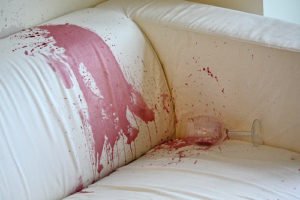
Nothing is worse then a sudden spill on a beautiful sofa or chair, or finding a new stain that wasn’t there before. It’s upsetting and most people react by immediately cleaning things.. During moments like this, it’s important to be cautious since many upholstery fabrics are delicate. The wrong cleaning agent or rubbing too hard can cause permanent damage. In all cases, over-wetting can cause water rings which are often difficult to treat.
For a significant spill, gently blotting the spill inward helps prevent it from spreading. For small stains, the right cleaning agent makes the difference. Generally, you should contact an professional upholstery cleaner because many upholstery materials are sensitive to certain types of cleaning agents. Cleaning fabrics typically requires skill, professional equipment and the right cleaning products.
Typically a cleaning tag is placed on the furniture frame below the cushion. These tags are guides for consumers and list codes that provide insight about what products should be used to clean. Some examples are:
W – use water based cleaning agents. S – use solvent based cleaning agents. X – don’t clean with either water or solvent-based agents. Vacuum or brush
Water based cleaning products are the most commonly used. The types that are marketed to take out every stain are usually far too strong and should be avoided. In all cases, an inconspicuous area should be tested. Using less is better to avoid creating bigger stains or spreading the damage. Hiring a professional can help you avoid problems.
Solvent based agents are used for oily stains such as grease. They tend to leave an oily residue. The type of equipment used by professionals help remove the solvents and provide a more consistent finish.
Some materials such as velvet will display an S code meaning solvents are recommended because the material pile easily distorts when wet. However, professionals will typically use water based cleaning agents and carefully brush and groom afterwards. As such, solvent residues don’t have to be removed.
Food Dye Removers – Red wine stains and other difficult colored stains should not be attempted by a consumer as they need to be carefully taken out with more sophisticated cleaning agents and rinsed out.. Delicate materials require precision cleaning to avoid damage such as color loss.
Important Tip – Try not to rub the material aggressively or repeatedly as the texture can be easily damaged which is irreversible.
Easy to clean fabrics – Microfibers such as Ultrasuede and Performance Fabrics are growing in popularity. They are great for households with children and pets. Unlike natural fibers such as cotton and wool, they’re designed to repel stains. Often a small amount of water, which is neutral, can be gently applied to a minor stain for simple removal. Less moisture is better along with rubbing gently.
We clean most fabrics and have had great success at removing water marks that many companies claim are permanent. Tremendous experience has been an invaluable guide.

